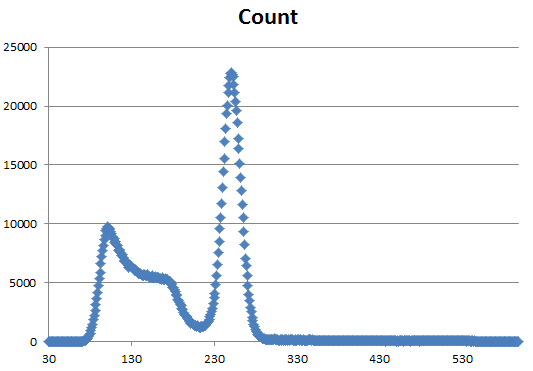Lab Book 2014_08_12 Hamilton Carter
Summary: Managed to do useful work in the lab today! I got ahold of a different NaI detector and this one works! I took some base level spectra and I'm working on getting the 30 keV line in the Cs 137 spectra visible. If I can get there, then the detector system is ready to go for the experiment, and spectrum testing in the liquid helium Dewar can begin.
If you're new to the experiment, scroll to the bottom for background.
Got the new old dectector.
The tube that’s inside is equivalent to the B76D01. All the information is available on ADIT’s
web page: http://www.aditpmt.com/contact.html
The detector just works!!!
It’s triggering very frequently with nice clean pulses.
Common settings for both the following runs: threshold = 1.5 mV. Gate width = 0.5 uS
Started Cs137 run at 2:41 PM
ended at about 3:12 This one has
6 dB attenuation
Started second Cs137 run at 3:17. This one has no attenuation. Did not collect data. Their was no new spectral structure, (no new
peaks). Trying again with the bias
voltage turned up.
Started a run at approximately 3:57 PM with the following
changes. The bias voltage was set to
1400 V instead of 1100 Volts. Ended run
at about 4:32. Need to keypunch data
tomorrow.
Started background run under same conditions about 4:38? Also need to keypunch data.
Background
Hirsch's theory of hole superconductivity proposes a new
BCS-compatible model of Cooper pair formation when superconducting materials
phase transition from their normal to their superconducting state[1]. One
of the experimentally verifiable predictions of his theory is that when a
superconductor rapidly transitions, (quenches), back to its normal state, it
will emit x-rays, (colloquially referred to here as H-rays because it's
Hirsch's theory).
A superconductor can be rapidly transitioned back to its normal state by placing it in a strong magnetic field. My experiment will look for H-rays emitted by both a Pb and a YBCO superconductor when it is quenched by a strong magnetic field.
A superconductor can be rapidly transitioned back to its normal state by placing it in a strong magnetic field. My experiment will look for H-rays emitted by both a Pb and a YBCO superconductor when it is quenched by a strong magnetic field.
This series of articles chronicles both the experimental lab
work and the theory work that’s going into completing the experiment.
The lab book entries in this series detail the preparation and execution of this experiment… mostly. I also have a few theory projects involving special relativity and quantum field theory. Occasionally, they appear in these pages.
The lab book entries in this series detail the preparation and execution of this experiment… mostly. I also have a few theory projects involving special relativity and quantum field theory. Occasionally, they appear in these pages.
Call for Input
If you have any ideas, questions, or comments, they're very
welcome!
References
1.
Hirsch, J. E., “Pair production and ionizing radiation from
superconductors”, http://arxiv.org/abs

Comments
Post a Comment
Please leave your comments on this topic: